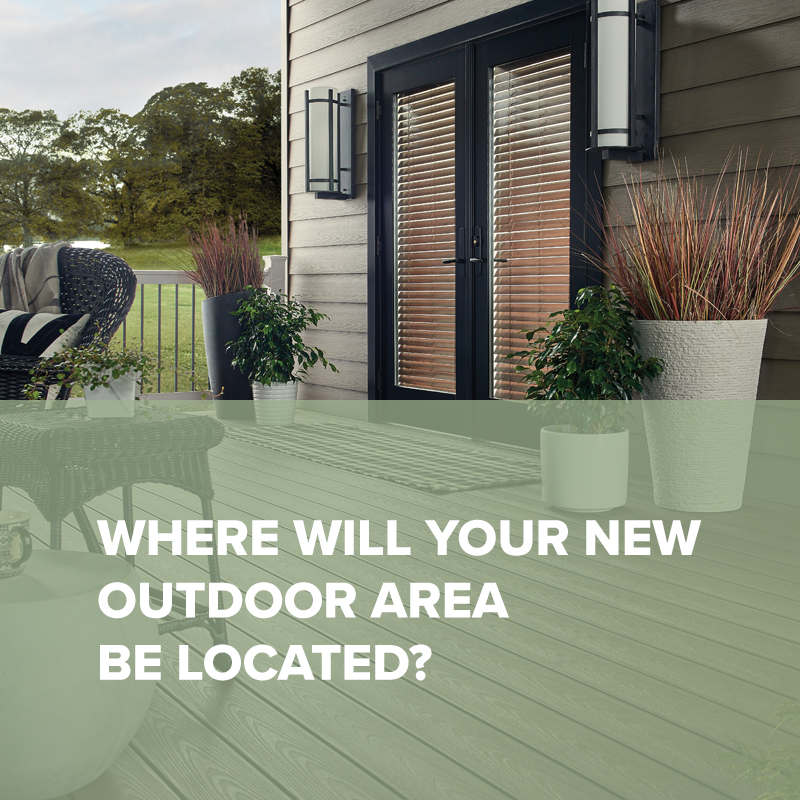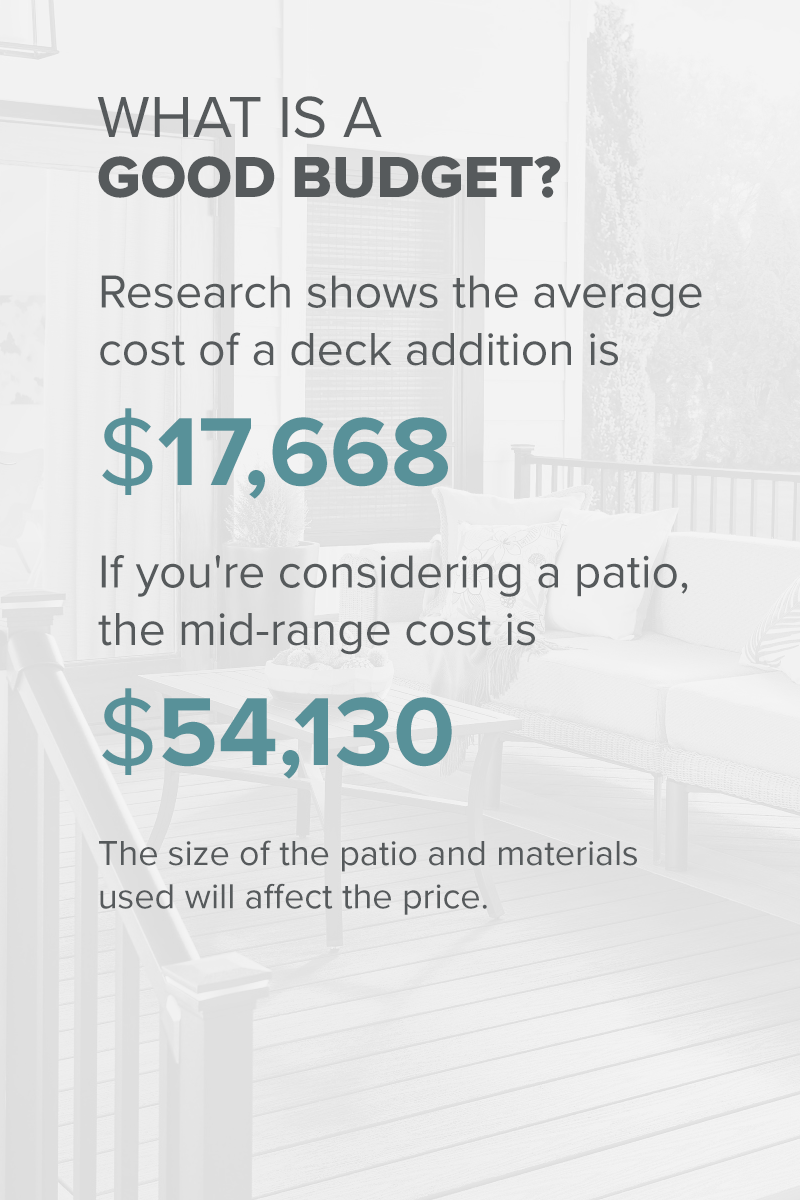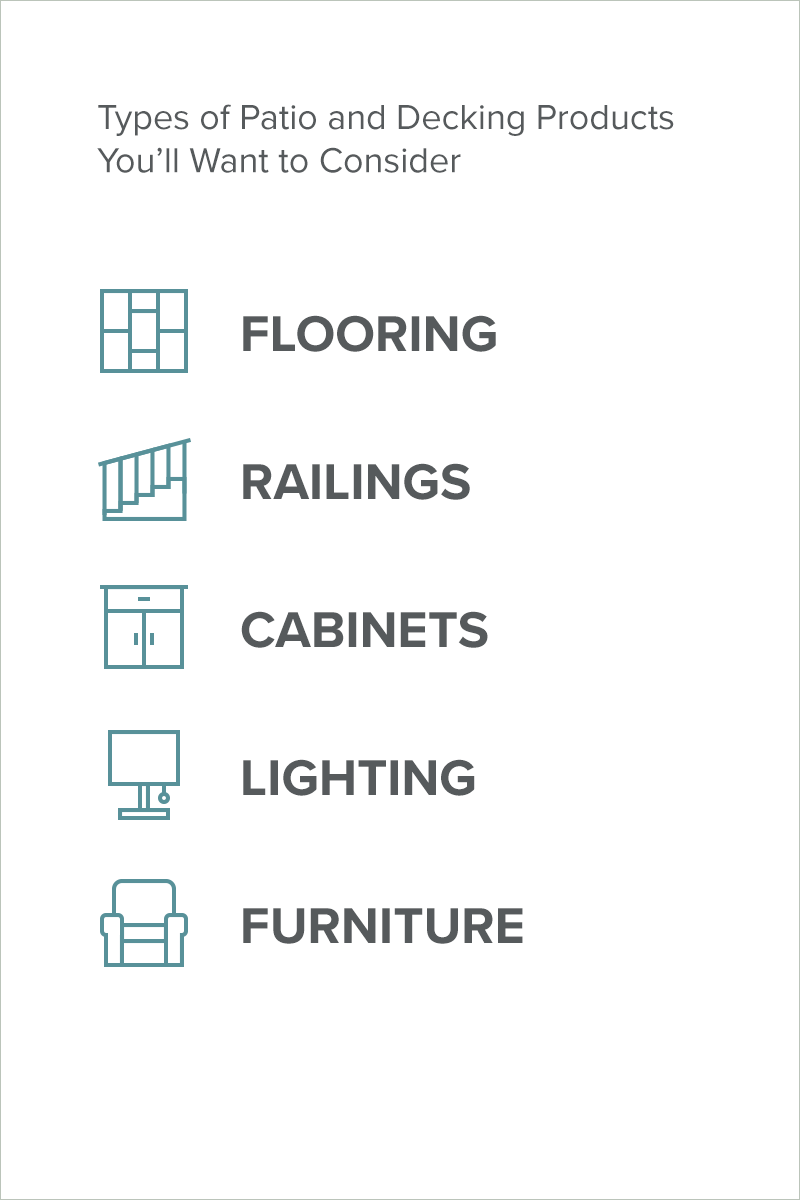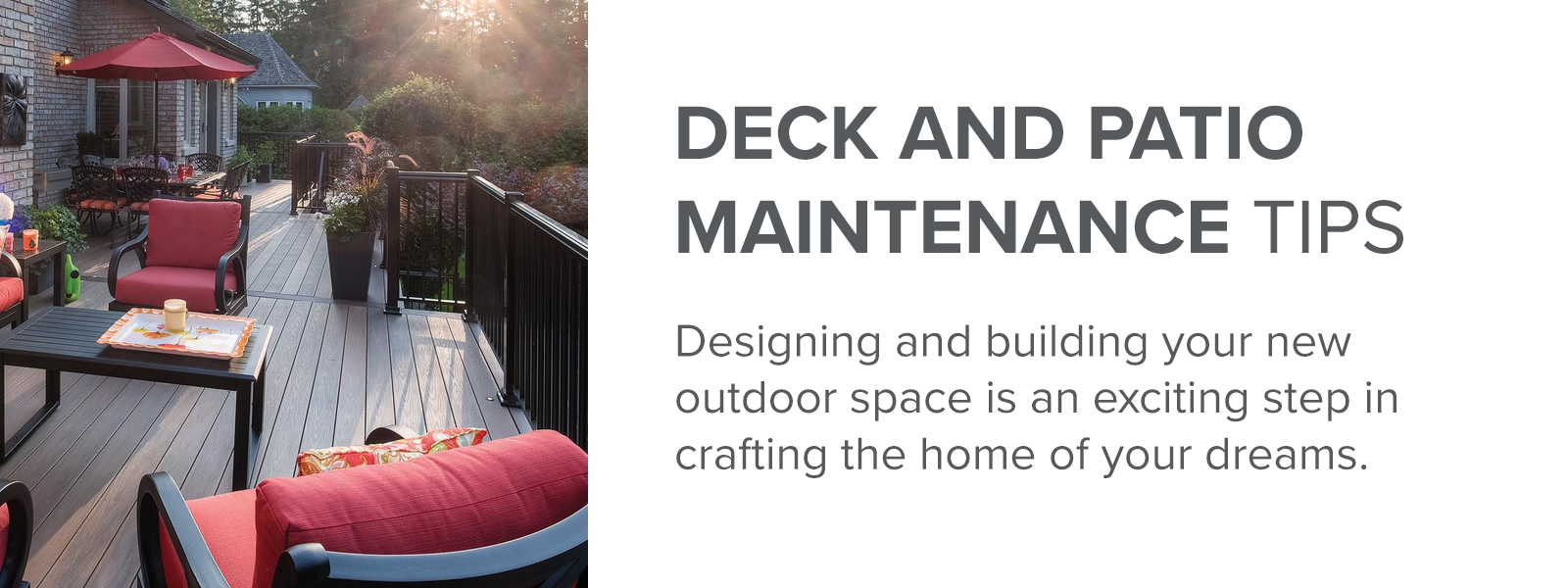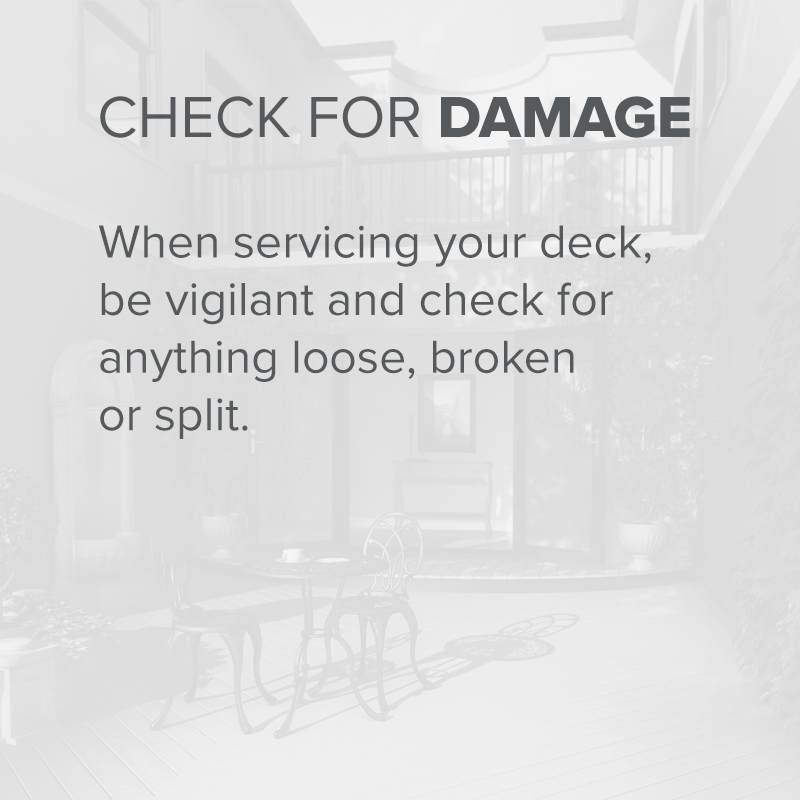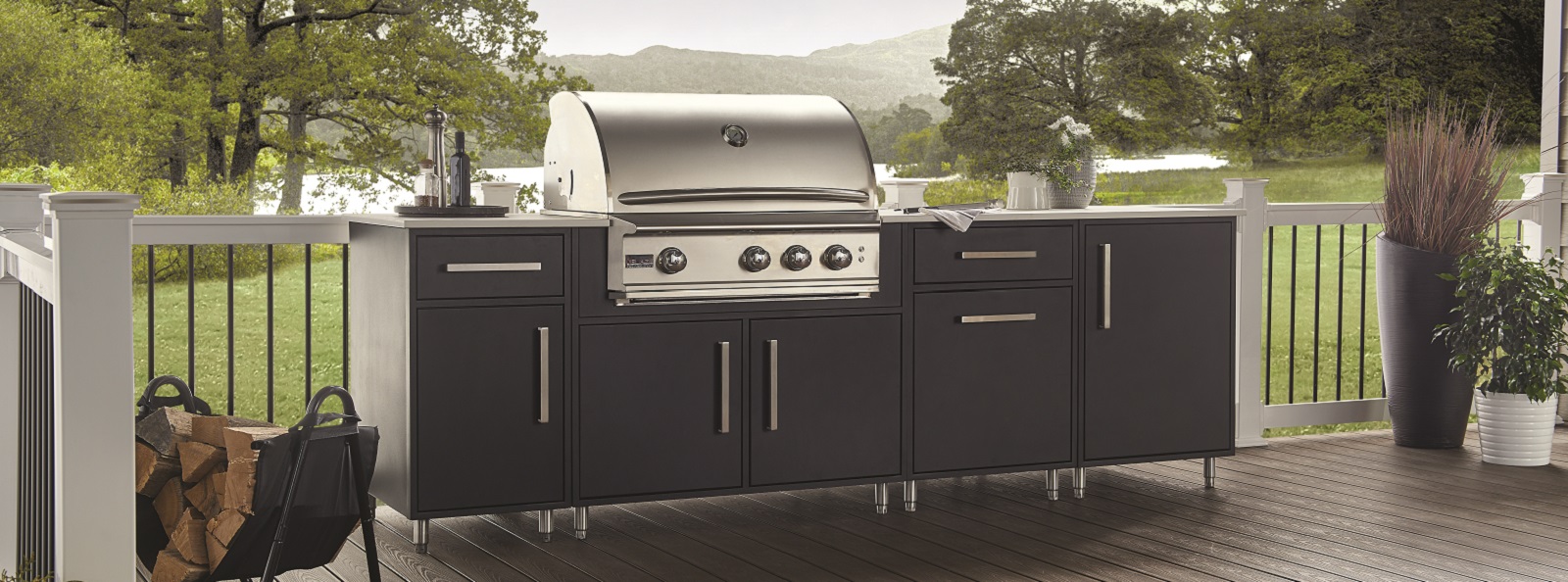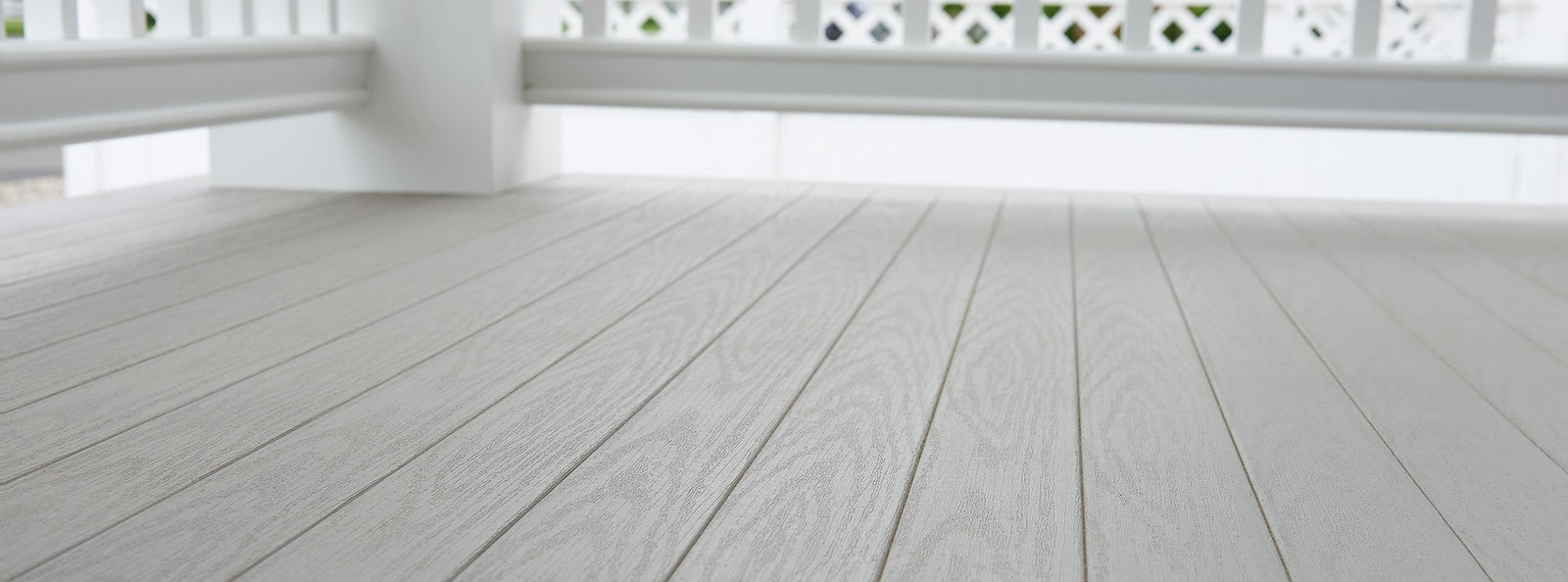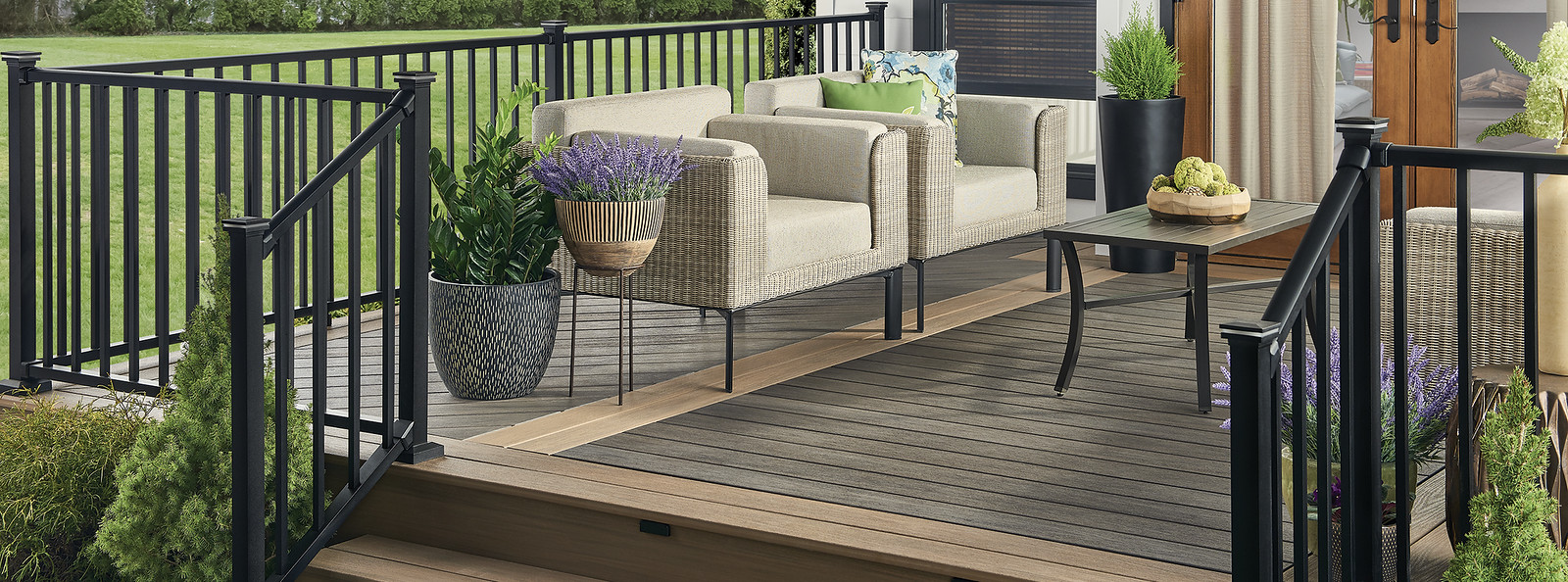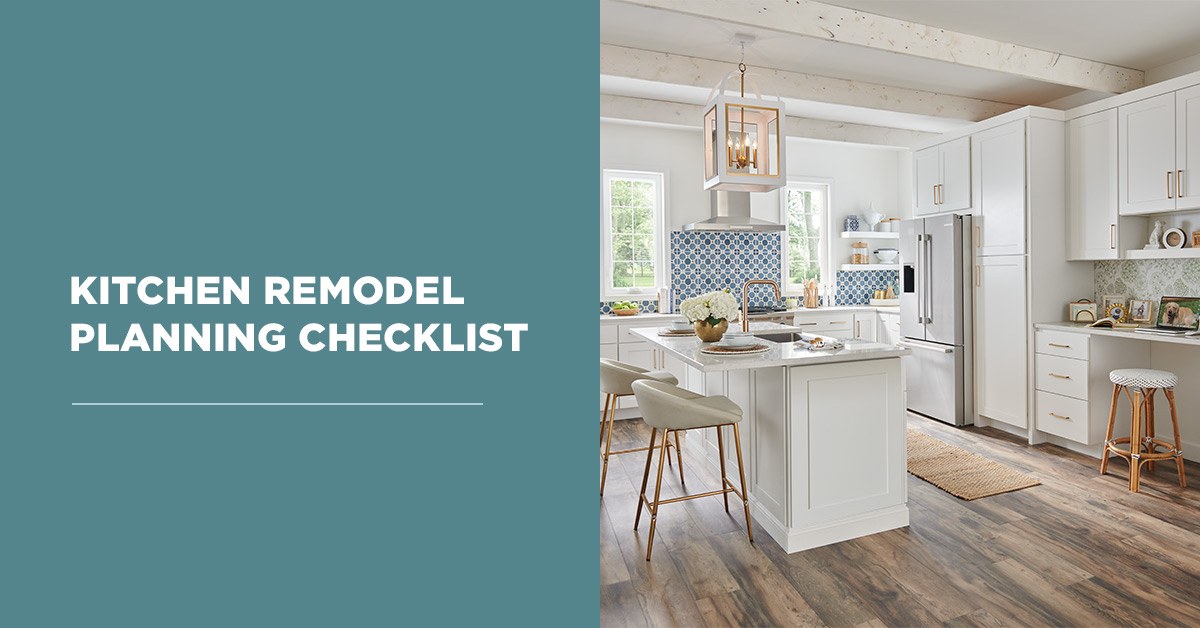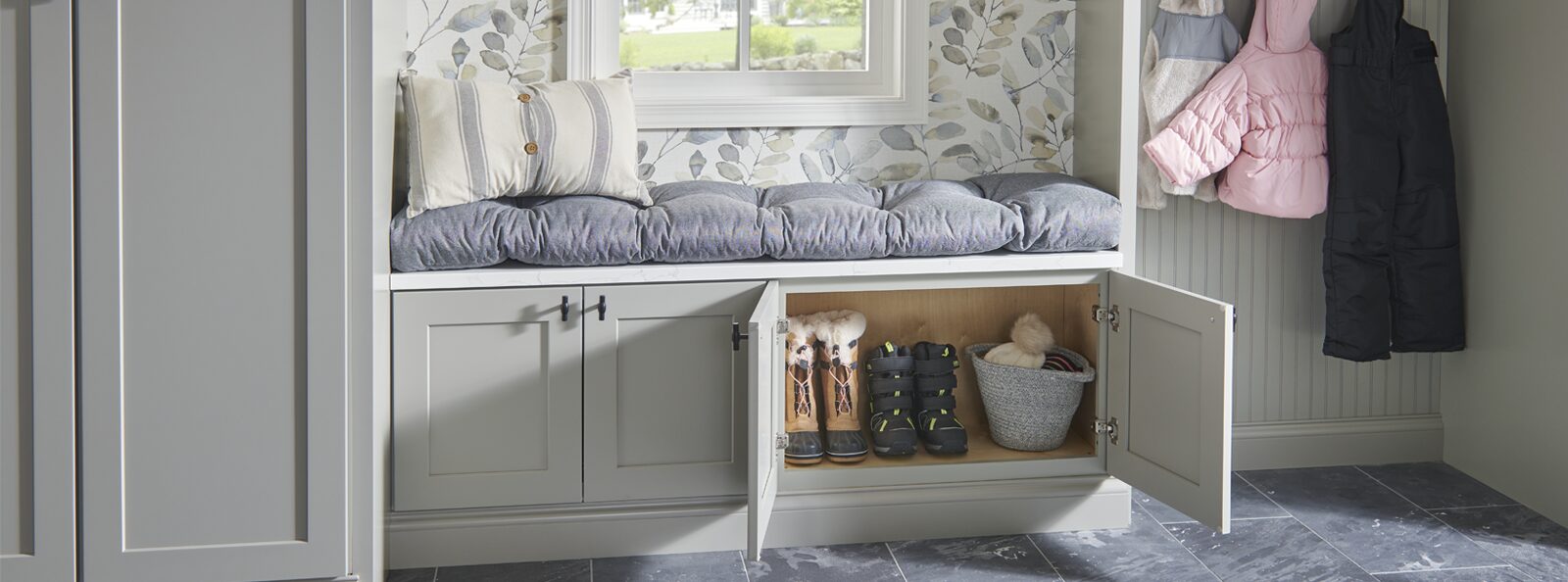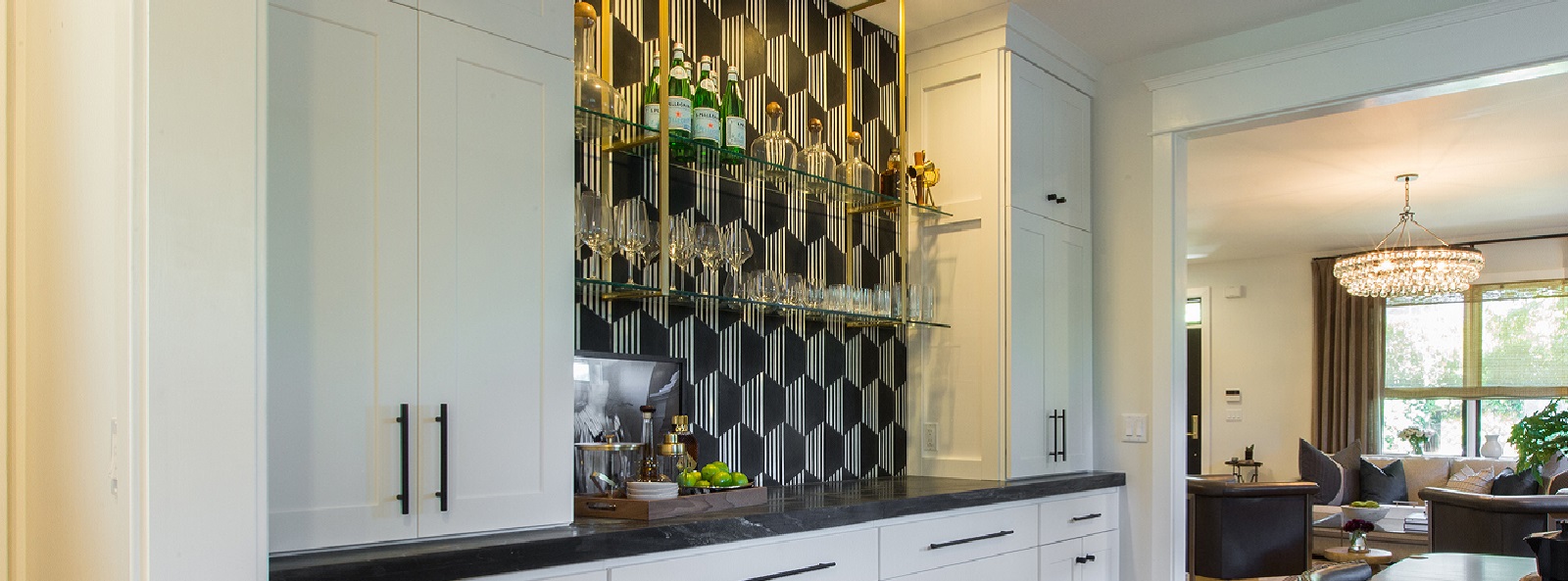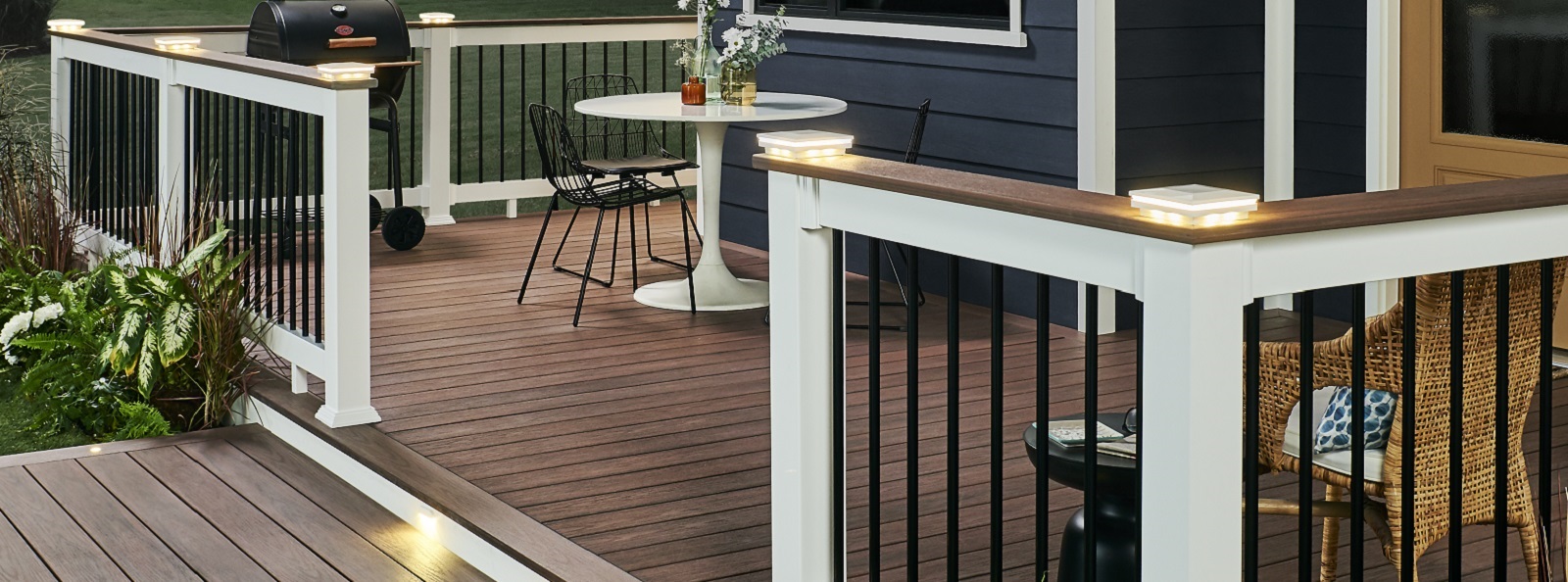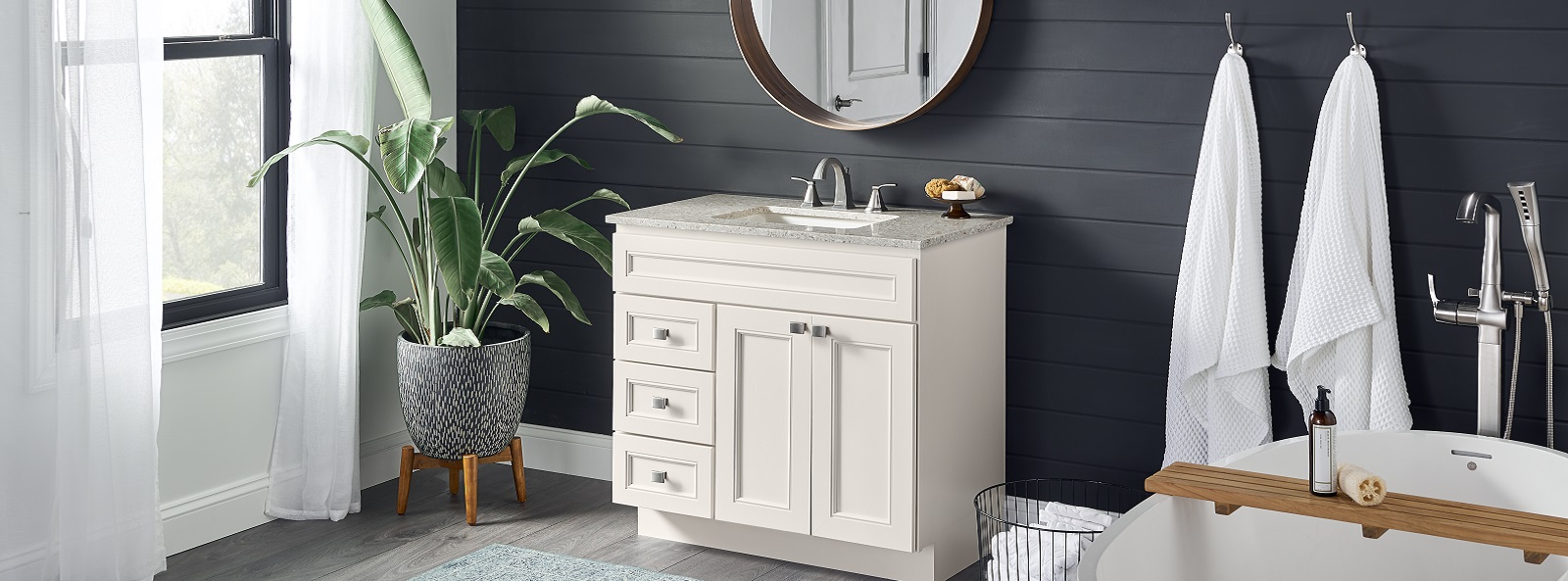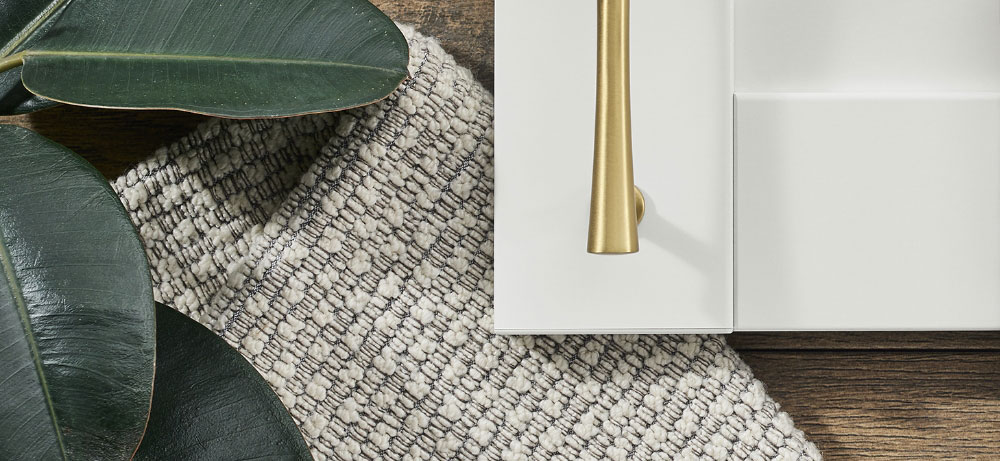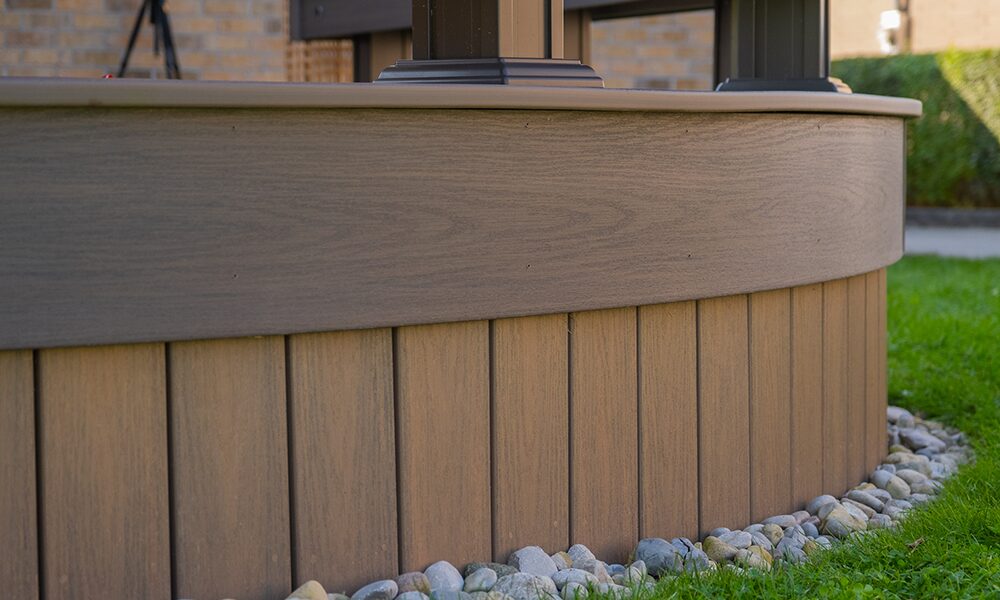
YOUR ULTIMATE DECK AND PATIO GUIDE
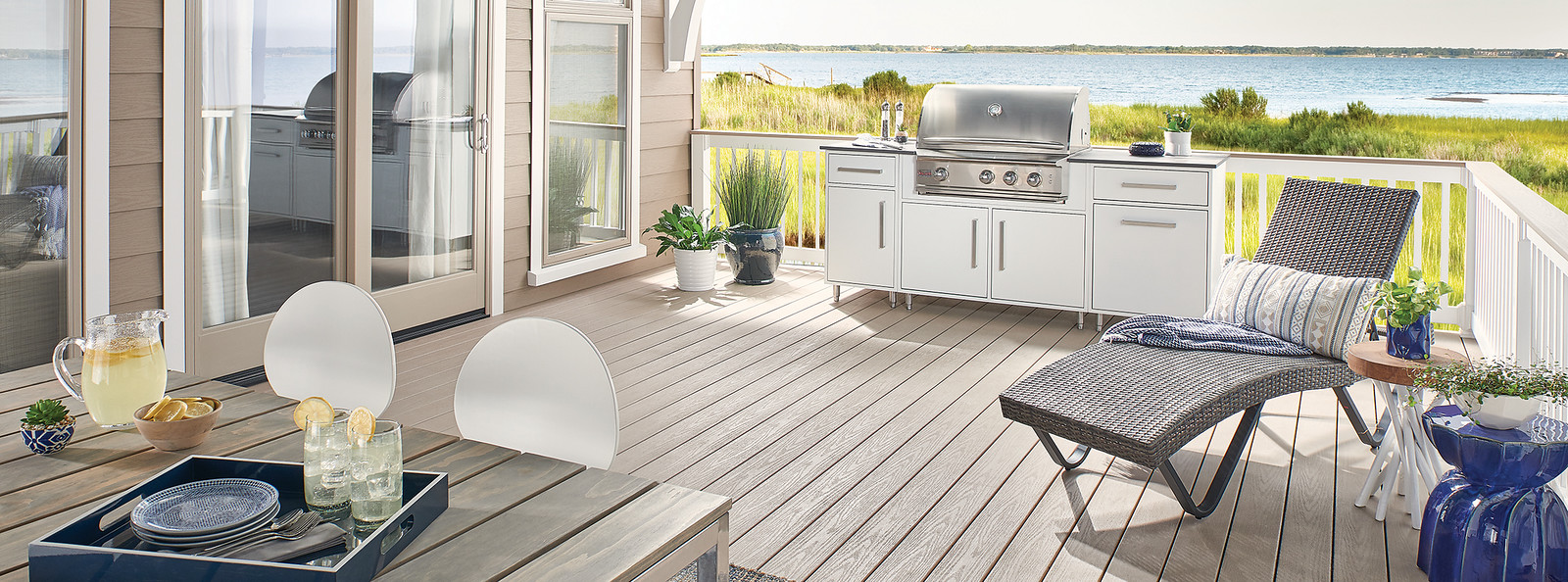
Looking for ways to upgrade your home? There are plenty of enhancements to choose from. You might refinish the basement or attic, or perhaps build an addition to or add another bedroom. Maybe you’ll revamp that garage into your dream workshop.
One of the most exciting ways to upgrade your home is by creating an outdoor living area. Adding a deck or patio allows you to experience the outdoors while still maintaining the comforts of home. Even if you think you’re the type of person uninterested in a deck or patio, think again! These spaces can be designed in all shapes, sizes and varieties. One size definitely does not fit all, and there’s sure to be the perfect deck or patio out there for you.
Maybe you’re interested in adding one of these spaces but don’t know where to get started. If you’ve never had one before, you’re probably a little unsure how to appropriately plan for a deck or patio.
To help you get started with your outdoor project, we’ve put together the ultimate deck and patio planning guide — so you can become an expert on the patio and deck planning process.
HOW TO PLAN THE PERFECT OUTDOOR LIVING SPACE: WHAT TO CONSIDER WHEN DECK PLANNING AND PATIO PLANNING
Before you begin diving into the real nuts and bolts of construction, let’s review some of the primary deck and patio topics you need to consider. Once you have these categories nailed down, you can move forward with some of the smaller details.
1. WHERE WILL YOUR NEW OUTDOOR AREA BE LOCATED?
One of the first things you need to determine is the location of your deck or patio. To do this, you want to take a close look at your property and yard to select the best possible location for your outdoor living space. Most people like the idea of keeping their deck or patio as close to their house as possible. Many people even choose to create this space in such a way that it’s actually attached to the house.
However, making your deck or patio close to the house isn’t the only option. If you have the space for it, you can also position your deck across the yard from your house, making this a kind of mini-retreat in your own backyard.
You might even install a charming stone path, or a similarly elegant and creative pathway through your yard leading to your deck. If you plan on eating on your patio, it will be most convenient to keep this space close to the kitchen. Otherwise, you’ll find that carrying food out across the lawn gets old quickly!
Also, consider the impact that weather or water issues may have on your outdoor plans. Find a space that works for your plans — determining whether it’s attached to your house or not is completely up to you.
2. WHAT IS A GOOD BUDGET? 
Another important factor to consider early on is the price. This will help you as you consider size, materials and professional help. Realistically, we all have project budgets. Yours might be large, it might be small or it might be somewhere in between. The specific size of your budget will be unique to you, and its size doesn’t matter as much as establishing and adhering to it does.
It can be difficult to find an average price for a new outdoor living space because each project varies so much. One contractor might be more expensive than another. Some decking materials will be more cost-effective than others. Research shows the average cost of a deck addition using composite materials is $17,668. The cost can vary depending on the size of the deck and which type of decking is used. If you’re considering a patio, the mid-range cost is $54,130. Again, the size of the patio and materials used will affect the price.
It’s important to stress the absolute importance of creating a budget. If you do not set yourself a price limit — or even research general costs — it’s all too easy to overspend before you realize it.
Sit down with your spouse or anyone else who has a say in this decision-making process and figure out how much money you are willing to spend on a new deck or patio. What’s the maximum you’re willing to spend to create your ultimate deck or patio?
Creating a budget like this may seem like a hassle, but it’s a great way to help yourself stay on track as you plan.
3. HOW MUCH SPACE DO YOU NEED?
Size is important when it comes to designing your outdoor relaxation space. You want it to be large enough that everyone is comfortable and doesn’t feel like they’re on top one another, but you don’t want it so large that you have to shout from one end to the other to hold a conversation.
Wondering how you gauge the size of your new outdoor living area? An excellent place to start is with a headcount. How many people will use the space on a regular basis? While it’s impossible to predict the exact number that will attend every gathering you ever host, it’s certainly possible to arrive at a rough estimation.
Rarely have guests over? Keep your space small and cozy. Do you frequently entertain extended family or large parties? As you can imagine, this means your space will need to be a bit larger.
If you’re having trouble estimating how a certain number of people translates into the specific square footage, try this trick: Cluster enough lawn chairs, picnic tables and other pieces of fuiture around in a seating arrangement that would comfortably suit the number of people you have in mind. Take a good look at how much space this takes up. Jot down some measurements. This exercise should give you a rough idea of the amount of deck space you’ll need.
4. WHAT MATERIALS WILL YOU USE? 
Once you have a rough idea of where you’re going to be building and how large your deck or patio is going to be, the next step is to think about materials.
As with anything else, there are numerous choices on the types of materials you can use for your deck or patio. Flagstone, concrete, brick and slate are the most popular material choices for a patio. For decking, composite and PVC materials are becoming increasingly popular over traditional wood.
Not sure how to go about choosing your material? Here are a few factors you should think about when making a patio or deck material selection:
- Matching Style: Your house already has a specific look and feel to it. Ideally, your new deck or patio should blend seamlessly with this pre-existing style. To do this, choose a material that pairs well with your house’s design.
- Preference: Which materials do you best like the look of? Ultimately, this is your deck, and you should choose a material that you find beautiful.
- Price: Each material will come with a different price tag. This will be key in affecting your decision, as you’ll want to select a material that falls within your pre-determined budget.
5. WILL YOU NEED TO HIRE A PRO?
One of your biggest questions is probably this: Do you need a professional, or can you do it yourself?
This is dependent on the size and scope of your project. If you have some experience with handy work, and your planned project is reasonably small and uninvolved, you can launch a do-it-yourself project. A small sand-based patio, for instance, is something you can likely take care of with some research, planning and sweat.
However, if you’re planning a more massive project, such as one that involves installing composite decking and other more demanding tasks, you may need to enlist the pros. They will ensure that the job gets done right, is code compliant, no one gets hurt and leaves you with the deck or patio of your dreams.
TYPES OF PATIO AND DECKING PRODUCTS YOU’LL WANT TO CONSIDER 
With an understanding of broad project categories under your belt, now it’s time to get into some of the nitty-gritty. As you begin to get into the more specific details of your project plans, it can be hard to keep track of everything you need to be thinking about.
To help you get all your ideas together, run through this list of products you’ll likely want to add to your deck or patio.
1. FLOORING
No matter what type of space you’re building, you will need to include a base floor. If you’re building a traditional deck, this floor will likely be made out of wood or composite decking, like our Wolf PerspectiveTM Decking.
2. RAILINGS
Again, this will largely depend on what the space you’re designing looks like. If your patio or deck is a raised platform, you will certainly want or need to add railings. These will help provide an extra level of safety and keep you, your family and guests from accidentally falling off the raised deck. Even if your space isn’t raised, a railing can still provide a beautiful barrier that helps set your space away from the rest of the yard.
Ideally, you will choose a material for your railing that complements your flooring and the rest of your home. This might be wood, plastic, metal or something else entirely. Whatever you choose, it should help tie the whole design together and give it a uniform look.
3. CABINETS
Are you looking to add some storage to your new outdoor space? Maybe you have outdoor games, grilling supplies or extra outdoor cushions you need to store. If you’re looking for this kind of accommodation, consider adding cabinets into your new outdoor space.
As with most of the other products we’ve discussed, these can be purchased in a variety of different materials to match any established aesthetic. They can be attached or free-standing depending on your needs, and come in many different sizes. No matter what you’re looking to store, you can find a cabinet the right size.
4. LIGHTING
Your outdoor space will have plenty of light during the day, but what about when you want to relax out there at night? For your space to be as functional as possible, you’ll want to install outdoor lighting.
There are so many options for outdoor lighting that no matter what style you’re looking to match, you’ll find something you like. These lights can be traditional light bulbs or string lights. They can be solar-powered or wired into your home’s electrical system. They can hang from the ceiling or they can be built directly into railings.
To get an idea of just some of the lighting options available today, browse our outdoor lighting selection and get a feel for what style will fit your new deck or patio space.
5. FURNITURE
Of course, what outdoor deck or patio space would be complete without fuiture for you, your guests and your family?
Remember the headcount layout you performed earlier? Now is the time to remember the number you arrived at and provide seating for all. At the bare minimum, we recommend including enough seating options so that everyone is comfortable. Maybe this is just your family, or maybe it includes a group of friends that are nearly always visiting you. Make sure they can all relax comfortably together on your deck.
Not sure what other fuiture to include? Think about how you’ll be using this space. Do you plan to eat out on your deck frequently? Then you’ll want to include a large table and chairs. Will you be hosting casual get-togethers in the summer? Consider adding a few small tables to hold drinks and finger foods. Think you’ll frequently be relaxing out here with a good book? Don’t forget to add a lounge chair, or something equally spacious and comfy.
DECK AND PATIO MAINTENANCE TIPS
Designing and building your new outdoor space is an exciting step in crafting the home of your dreams. But, as a new deck owner, you’ll also want to spend time thinking about short and long-term plans for your deck. Specifically, it’s worth spending a little extra time thinking about deck maintenance.
Here are a few of our best tips for maintaining and caring for your deck and patio.
1. THINK ABOUT THE TIME OF YEAR
While you can certainly clean your deck any time of the year, there are particular seasons when it makes the most sense and are most convenient to give your deck a little extra care. Because your deck or patio is a space that will primarily be used during the summer, it makes the most sense to clean in the fall and once again in the spring.
Think of spring deck maintenance as just another part of your spring cleaning. As you get everything set up for summer, spend extra time making sure everything on the patio functions and nothing is broken. If something does need attention, fix it before your patio experiences heavy use in the warm weather of summer.
Likewise, when you close down the patio for the end of the season, give it a once-over to check for anything that might have broken or been damaged during the summer. You don’t necessarily have to fix it now, but make a note of it so that you can address damage come next spring when you set the patio up again.
2. CHECK FOR DAMAGE
The type of damage you’re likely to discover on your deck or patio will vary greatly depending on what kind of material your space is made from. In general, however, there are a few universal problems to keep an eye on.
When servicing your deck, be vigilant and check for:
- Anything loose: Loose boards, screws, railings or cabinets mean your space isn’t as safe as it could be. Make sure everything is secured tightly in place, especially after a long winter of cold, ice and snow.
- Anything broken: If anything is broken or cracked, it should be replaced. Not only is this unsafe, but it means your space won’t function correctly. For your patio to be the best it can be, repair anything broken or replace it altogether.
- Anything split: Extreme cold, ice and even heat can sometimes cause materials to crack. Give your deck a solid examination to make sure this hasn’t happened to your materials.
3. DO SOME GENERAL CLEANING 
Of course, you can never go wrong with some good old-fashioned cleaning. Depending on the materials used in your patio, you may want to use a hose and dish soap (Dawn works great!), or you might want to use a pressure washer. Give your deck this cleaning before summer starts to remove all traces of winter’s grime and dirt. This will have your space looking beautiful and ready for the upcoming season.
4. LOOK FOR MOSS, MOLD AND MILDEW
Moss, mold and mildew can lead to musty odors, decrease the structural integrity of your deck and look unsightly. Do a thorough check for these in both the fall and the spring, and remove them immediately if you find any traces.
In addition to the problems that molds and other growths cause, they’re also a sign of poor drainage and excess moisture on your deck and patio. If you notice moss or mildew building up somewhere on your patio, take this as a sign that a deeper investigation may be required to get to the root of the problem.
GET STARTED DESIGNING YOUR DECK TODAY
If you’re feeling nervous or unsure about the planning process for your new deck or patio, we hope this advice has provided answers. You should feel empowered and confident in your home’s projects, ready to start planning the outdoor oasis you’ve always imagined. By following these tips, you’ll be well on your way to making that dream a reality.
Once you’ve got some initial plans in place, it’ll be time to begin shopping for materials and finding a contractor. When that time comes, find a Wolf dealer to purchase materials or contact a Wolf contractor to help with your project.
Wolf is a leading supplier of outdoor and building products. Our company is founded on over 175 years of tried-and-true experience. You deserve the very best products available today, and we deal in high-quality materials and fixtures at prices that fit neatly into your budget. View our gallery for more outdoor living inspiration.

